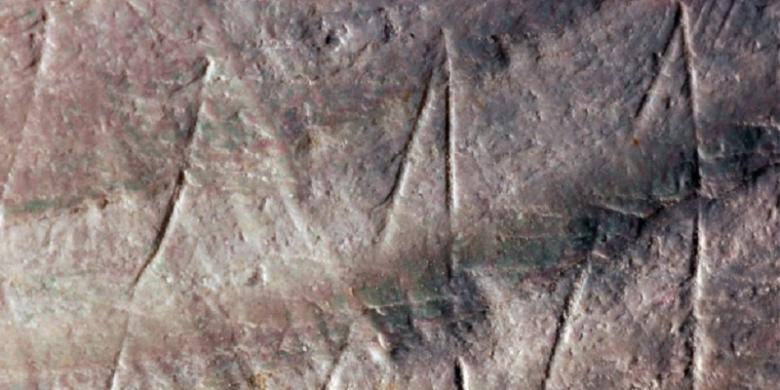 |
| Original Title: Terkuak, Gambar Kuno Tertua di Dunia Berasal dari Tanah Jawa |
Jakarta (DreamLandLibrary) - The oldest nicks in the world found on the shell apparently come from the land of Java, precisely from the Trinil site, Ngawi, East Java. Research published in Nature on Monday (1/12/2014) revealed it.
Josephine CA Jordens, a researcher at the Faculty of Archeology at the University of Leiden, the Netherlands, and her colleagues is the party that confirms that the incision is the oldest, dating from the period of 500,000 years ago.
Jordens is working on a research project on the use of marine resources by the ancient human species Homo erectus at the Trinil site, East Java. He then analyzed the freshwater shells of the Pseudodon vondubangchianus trinilensis species.
When analyzing, he found perforations or small holes a few millimeters wide on the surface of the shells. According to him, it was an indication that there were people at that time who tried to open the shell with sharp tools like shark teeth.
Jordens' colleagues then took a picture of the shell and examined it in more detail. Through careful observation, it is known that the surface of the shell has zig-zag-shaped nicks.
Observation under a microscope then reveals that the zigzag pattern was made intentionally. The zigzag lines, each of which are 1 cm long, are continuous, unbroken, showing that the maker is paying attention to details.
Jordens and colleagues dated the sediments contained in shells with argon and luminescence. The results of the calendar reveal that the zigzag pattern originated from 500,000 years ago, not made by Homo sapiens, but Homo erectus.
"This discovery is very spectacular and has the potential to change our perspective about Homoawal (ancient humans)," said Nick Barton, an archeologist from Oxford University who was not involved in the study.
Is the incision an art form? Jordens said, "If you don't know the purpose of someone who made it, then it's impossible to call it art."
Josephine CA Jordens, a researcher at the Faculty of Archeology at the University of Leiden, the Netherlands, and her colleagues is the party that confirms that the incision is the oldest, dating from the period of 500,000 years ago.
Jordens is working on a research project on the use of marine resources by the ancient human species Homo erectus at the Trinil site, East Java. He then analyzed the freshwater shells of the Pseudodon vondubangchianus trinilensis species.
When analyzing, he found perforations or small holes a few millimeters wide on the surface of the shells. According to him, it was an indication that there were people at that time who tried to open the shell with sharp tools like shark teeth.
Jordens' colleagues then took a picture of the shell and examined it in more detail. Through careful observation, it is known that the surface of the shell has zig-zag-shaped nicks.
Observation under a microscope then reveals that the zigzag pattern was made intentionally. The zigzag lines, each of which are 1 cm long, are continuous, unbroken, showing that the maker is paying attention to details.
Jordens and colleagues dated the sediments contained in shells with argon and luminescence. The results of the calendar reveal that the zigzag pattern originated from 500,000 years ago, not made by Homo sapiens, but Homo erectus.
"This discovery is very spectacular and has the potential to change our perspective about Homoawal (ancient humans)," said Nick Barton, an archeologist from Oxford University who was not involved in the study.
Is the incision an art form? Jordens said, "If you don't know the purpose of someone who made it, then it's impossible to call it art."
"However, on the other hand, this is an ancient picture. This is a way to express yourself. What is the purpose of the people who made it, we do not know," Jordens said as quoted by Nature, Wednesday (12/03/2014).
Clive Finlayson, animal expert from the Museum of Gibraltar who was also involved in the study, said the most important of these findings was that early humans already had the ability to think abstractly, just like modern humans.
The shells analyzed were found by paleontologist Eugene Dubois at the Trinil site in 1896. Dubois also discovered the skeleton of Homo erectus. The skeleton and shell were then sent to the Leiden Museum in 1930.
Source: http://sains.kompas.com/read/2014/12/04/19405611/Terkuak.Gambar.Kuno.Tertua.di.Dunia.Berasal.dari.Tanah.Jawa
Image Source:
http://assets.kompas.com/data/photo/2014/12/04/1932040gambar-zig-zag780x390.jpg
Clive Finlayson, animal expert from the Museum of Gibraltar who was also involved in the study, said the most important of these findings was that early humans already had the ability to think abstractly, just like modern humans.
The shells analyzed were found by paleontologist Eugene Dubois at the Trinil site in 1896. Dubois also discovered the skeleton of Homo erectus. The skeleton and shell were then sent to the Leiden Museum in 1930.
Source: http://sains.kompas.com/read/2014/12/04/19405611/Terkuak.Gambar.Kuno.Tertua.di.Dunia.Berasal.dari.Tanah.Jawa
Image Source:
http://assets.kompas.com/data/photo/2014/12/04/1932040gambar-zig-zag780x390.jpg











